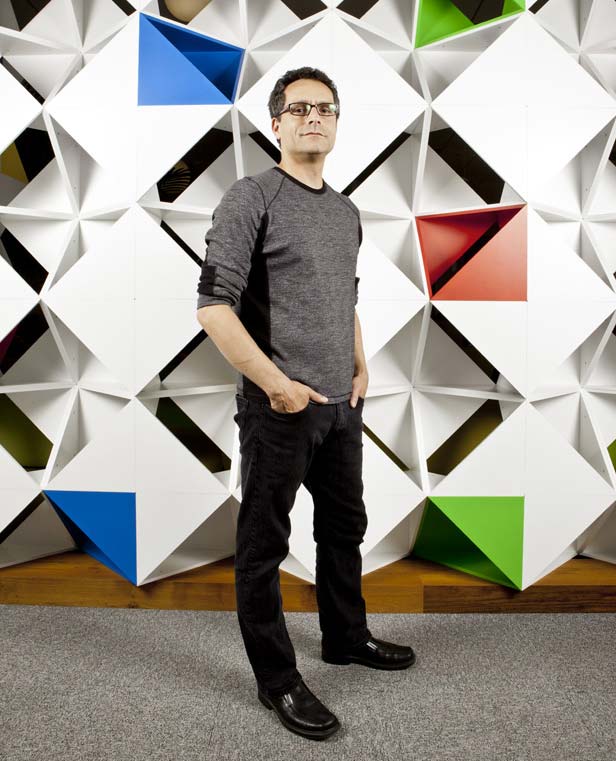Bradley Horowitz

Google mastered Web search and online advertising with math, but to compete with Facebook and Twitter for people’s attention it must figure out the trickier domain of human relationships. The task falls mostly to Bradley Horowitz, who helps lead Google’s development of social software and recently launched Google+, a network not unlike Facebook.
Horowitz wants it to become a social skeleton that supports every Google product, from search to advertising, with the goal of understanding people, their interests, and their connections. Google failed with earlier social efforts such as Buzz, which aped Twitter. But Horowitz says his team has learned from those mistakes.
He talked to Technology Review’s computing editor Tom Simonite about his hopes that Google+ will raise the standard of online social networking.
TR: What is wrong with the social networks that people already use?
Horowitz: We heard a lot that people are over-friended. They have an undifferentiated mass of “friends” because there’s a social obligation to accept every request, and they end up including everyone from legitimate friends to people they met at a conference to kindergarten classmates.
That inhibits both the quality and quantity of communication. You’re stepping up to a podium in front of this diverse group of people where almost nothing can resonate for all of them. That takes conversation down to the least common denominator, so you end up saying things like “stuck in traffic on 101” or “checked in to the Olive Garden.” It becomes drivel.
To address that, what assumptions did you make?
Users are faceted. There are many selves that a person has, not just one. We designed our product to recognize that, so that you can have the family self, the pub self, the work self, and special interests like cycling buddies. We’re trying to ensure that being social doesn’t necessarily mean being trivial or wasting time.
That explains Circles, your core feature, where people organize their contacts into lists. Doesn’t that create work for users?
It is a higher cognitive load, because you have to think about who you’re going to share something with each time. But we heard again and again that this is a burden that users wanted to bear in return for higher privacy. Privacy should be in your face all the time, not hidden away in a settings menu. We learned from Buzz that people are deeply concerned about privacy, despite this meme about the death of privacy and everything becoming public.
Are you trying to mirror real life more closely than sites like Facebook do?
In some cases we’re trying to catch up with the real world online so people’s expectations can be met. Our very biology is wired to understand physical constraints and limitations like the fact that sound doesn’t travel through walls—not everyone hears every conversation.
Even so, Google+ replicates much of what Facebook and Twitter do. To compete with them you’ll have to do entirely new things that neither does, right?
We’re only just starting to launch the features that will move the center of gravity of the product and what it’s good for. One thing is [Web] search. When you type “kite surfing” into Google+, you will see a live stream of content not only from people you know but also experts in the field, all ranked to be relevant.
How will other Google services change by incorporating personal information?
We recently added “+snippets” to Maps, so you can share exactly what you’re looking at on a map with friends, with one click. That’s the tip of the iceberg of what you [eventually] could do. When you look up directions, it could tell you of ride-sharing opportunities, or that someone you know is going to be taking the same train. If I’m visiting New York, I could be shown ratings and reviews by people I know that live in or visited the city.
It sounds like you’re reshaping the company as well as trying to build a better social network.
I think we are. We have to do this because we’ve reached a new stage of the Web. The first was the web of links, which Google really transformed with PageRank and Google search. The next phase was the phase of apps, which Google helped drive with things like Gmail and Google Maps. The next will be the web of people—the understanding that it is people who drive the vitality and content online. The opportunity here is for Google to start recognizing people. When we know who you are, your interests, and who you know—if you let us know that—we can transform all of your activities for the better in search, in Android, in Chrome, in YouTube, in Gmail, and across all we do.
You’ll have to move quickly to lure people away from Facebook, which has been adding ideas borrowed from Google+.
We don’t need to take users away from Facebook in the early going. [Google as a whole already has] a lot of users and simply needs to introduce them to a new mode of interacting with Google.
Keep Reading
Most Popular
Large language models can do jaw-dropping things. But nobody knows exactly why.
And that's a problem. Figuring it out is one of the biggest scientific puzzles of our time and a crucial step towards controlling more powerful future models.
How scientists traced a mysterious covid case back to six toilets
When wastewater surveillance turns into a hunt for a single infected individual, the ethics get tricky.
The problem with plug-in hybrids? Their drivers.
Plug-in hybrids are often sold as a transition to EVs, but new data from Europe shows we’re still underestimating the emissions they produce.
Google DeepMind’s new generative model makes Super Mario–like games from scratch
Genie learns how to control games by watching hours and hours of video. It could help train next-gen robots too.
Stay connected
Get the latest updates from
MIT Technology Review
Discover special offers, top stories, upcoming events, and more.